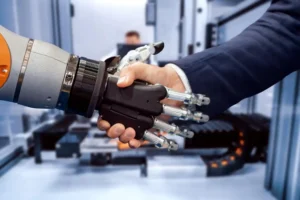In today’s world, technology is rapidly evolving, and automation is at the forefront of this transformation. From manufacturing plants to smart homes, automation and smart machines are reshaping industries, enhancing productivity, and making life easier. But what exactly is automation, and how do smart machines play a role? If you’re new to this field, this beginner’s guide will introduce you to the basics of automation and smart machines, explain how they work, and provide insights into their benefits and challenges.
What is automation?
Automation refers to the use of technology to perform tasks without human intervention. It involves machines, software, or systems that complete tasks traditionally done by humans. The goal of automation is to improve efficiency, reduce errors, and free up humans to focus on more complex tasks.
Automation is not limited to industrial applications. It’s used in various fields, including:
-
Manufacturing: Automated machines assemble products faster and more accurately than humans.
-
Healthcare: Automation helps streamline administrative tasks and manage patient data efficiently.
-
Home Automation: Smart devices like thermostats, lights, and security systems make home management more convenient.
How Smart Machines Work
Smart machines, on the other hand, are machines that can operate autonomously or semi-autonomously with the help of artificial intelligence (AI) and machine learning (ML). These machines gather data from their environment, analyze it, and make decisions based on predefined algorithms or through self-learning.
For example, a smart thermostat learns your temperature preferences over time and adjusts the temperature accordingly. Similarly, a smart vacuum cleaner can navigate your home, detect obstacles, and clean efficiently without human intervention.
Benefits of Automation and Smart Machines
-
Increased Efficiency: Automation speeds up repetitive tasks, allowing for faster production and less downtime.
-
Cost Savings: Smart machines can reduce labor costs and minimize errors, leading to lower operational costs.
-
Improved Accuracy: Machines can perform tasks with precision that is often beyond human capabilities, reducing the risk of mistakes.
-
24/7 Operations: Unlike humans, machines don’t need breaks. Automation allows businesses to run continuously, improving output.
-
Enhanced Safety: In industries like manufacturing, robots can take over dangerous tasks, reducing the risk of workplace injuries.
Types of Automation
Automation is not a one-size-fits-all solution. Different industries use automation in different ways, and there are several types of automation:
-
Fixed or Hard Automation: This type involves machines that are designed for a specific task, such as an assembly line in a factory.
-
Programmable Automation: Machines can be reprogrammed to perform various tasks, making them versatile.
-
Flexible Automation: This type involves systems that can adjust to changes quickly, allowing them to handle multiple tasks with minimal reprogramming.
The Role of Artificial Intelligence in Smart Machines
AI plays a critical role in making machines “smart.” By using algorithms, AI helps machines to learn from data and improve over time. For instance, in manufacturing, AI can predict when machines need maintenance, reducing unexpected breakdowns.
Machine learning (ML), a subset of AI, enables machines to make decisions based on data. Self-driving cars are a great example of how AI and ML combine to make smart machines that can navigate roads and make decisions without human input.
Challenges of Automation and Smart Machines
While automation and smart machines offer many advantages, they come with challenges:
-
Job Displacement: Automation may lead to job losses in certain sectors, particularly in industries that rely heavily on human labor.
-
High Initial Costs: The implementation of automation and smart machines can be expensive, which may be a barrier for small businesses.
-
Security Concerns: With increased connectivity, smart machines are vulnerable to cyberattacks, which can compromise their functionality.



